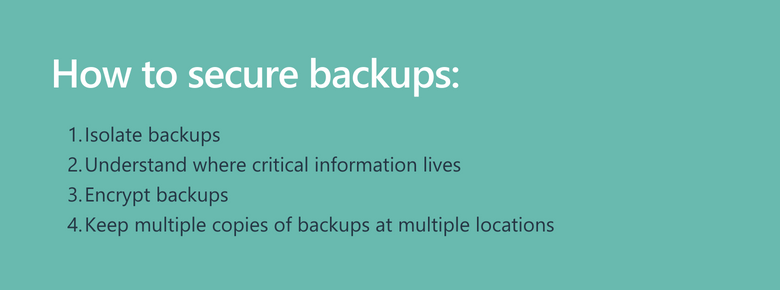OT Security Best Practices: Getting Backups Right
In recent years, attacks on OT assets and processes have become increasingly common and sophisticated, posing a significant threat to industrial environments. These attacks could even compromise the integrity of industrial environments to the point of causing physical harm. Shockingly, Gartner predicts that cyber attackers will have successfully weaponized operational technology (OT) environments to harm or kill humans by 2025.
Given the severe consequences of such attacks, it is essential for critical infrastructure organizations like the power generation industry and manufacturing industry to protect their OT environment—and one important element that is often overlooked is the security of backups. Secure backups are essential in an OT environment because they ensure that critical systems and data can be restored in the event of a cyberattack, equipment failure, or other disaster. Without secure backups, the recovery process can be time-consuming and costly and potentially lead to prolonged downtime and data loss.
Let’s explore how having solid backup and recovery processes in place can help you ensure minimal data loss in the event of a compromise.
Protect OT Systems’ Valuable Data Insights with Secure Backups
Operational technology environments are a powerhouse for producing the valuable data insights involved in sustaining everyday operations. Proactive maintenance and root-cause analysis, for instance, rely heavily on OT data. However, the flow of data between the IT and OT layers presents another layer of complexity that must be safeguarded at all costs.
Just imagine the consequences of an OT security breach that compromises information from SCADA or process control systems. How would that impact the performance of your organization—especially if it led to longer outages?
You may be thinking you can restore your data from a backup, but what happens if those backups are attacked as well?
To combat the risk of data loss, it is essential that you have secure backups in place to not only improve your overall OT security strategy but also to enable you to recover quickly in the case of a cyberattack and minimize outages. Protecting your critical data with secure backups is a crucial step in safeguarding your organization’s OT environment against cyber threats.
The Role of Backups in Your Incident Response Plan
To ensure your organization is prepared for the possibility of a cyberattack compromising your IT and OT data, developing an incident response plan that includes backups is critical.
Secure backups are a critical component of any cyber incident response process in an OT environment. If you find that your critical systems have been hacked and data is inaccessible, corrupted, or even lost altogether, your backups will help keep the business functioning by providing a way to restore critical systems and data in the event of a cyberattack or other disruption. Without them, the recovery process can be expensive, time-consuming, and potentially lead to prolonged downtime and data loss.
An incident response plan with backups isn’t a “nice-to-have”—it’s essential, as these best practices will help you react quickly to any threats to your enterprise and protect your bottom line.
How to Secure Backups

Now that we’ve discussed the importance of backups and an incident response plan in protecting your OT environment, it's important you secure them. When it comes to protecting backups, the same IT environment best practices apply to OT.
First, consider how often you need to perform a backup based on your data stream and your needs. For example, if you’re in an industry that follows unchanging compliance standards, you may not need to back up as frequently as another organization. You also need to identify whether your backup should be cloud-based and by whom it should be managed (i.e., internally or externally).
Backups aren’t something you set and forget. Regularly test and update backups to ensure they are up to date and accurate, and consider implementing the following tips to help protect your backups:
- Remove backups from your domain: Isolate backups and use a separate authentication system in case of stolen domain credentials.
- Understand where critical information lives: Know where your data is stored on the network and set priorities for recovering data in the case of a breach.
- Encrypt your backups: If backups are encrypted, your data will likely be safe.
- Keep multiple copies of backups at multiple locations: Have at least three different copies of important files, with at least two backup methods. Store one of them in a different location or within the cloud.
After defining the practicalities of your approach, establish how your recovery solution will minimize operational downtime in the event of an attack. Keeping an inventory of all of your assets and access points is a great start; however, your data-recovery process also needs to be completely preplanned to ensure a smooth response. Team responsibilities should be well defined and understood so your talent knows exactly how to respond and follow best practices. The last thing you want is to react just to react.
Help Implementing OT Security Best Practices
Luckily, you don’t need to handle your OT cybersecurity solution or backups alone. Partnering with an expert in both IT and OT can help you prevent operational outages, improve efficiency, and reduce security risk.
ProArch’s practice areas cover both IT and OT, and our expertise in the power generation industry and manufacturing sets us up well to strengthen OT security, progress IT/OT convergence best practices, and create a long-term strategy that enables growth while mitigating risk.
Learn more about our OT Security Services and OT Managed Services or reach out.

Director of Marketing Rebecca leads ProArch's marketing efforts, seamlessly blending technology and storytelling to assist clients in their buying journey. She is dedicated to presenting technological solutions in a compelling manner that drives significant growth for the company. Collaborating closely with sales, engineering, leadership, and HR teams, Rebecca sets the strategic vision for ProArch and ensures alignment across the organization. Her strategic, visionary, and detail-oriented approach shapes ProArch’s brand to be synonymous with reimagining technology to achieve business objectives.
